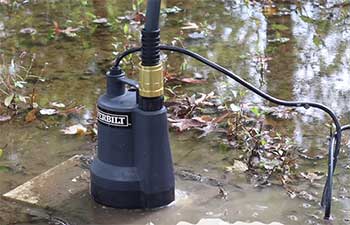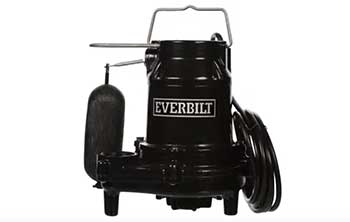If you have a flooding basement or need to move water away from your home or property, you may be debating between a utility pump and a sump pump. Both pumps serve similar purposes, but have key differences that make each better suited for certain applications.
This guide examines utility pumps and sump pumps in detail to help you decide which is the right choice for your needs.
A Brief Comparison Table
| Pump Type | Utility Pump | Sump Pump |
| Purpose | Versatile water removal and transfer | Remove groundwater from foundations |
| Installation | Portable and movable | Permanent in-ground sump basin |
| Power Source | Gas or electric motor | Electric with potential battery backup |
| Operation | Manual on/off or automatic float switch | Automatic float switch |
| Cost | $100-$500 | $150-$1000+ with installation |
Overview Of Utility Pumps
A utility pump, sometimes called a transfer pump, is a type of water pump designed for removing standing water or transferring water from one place to another. Utility pumps are portable and can be easily moved to where they are needed.
Utility pumps are versatile pumps that can be used for a variety of water removal tasks:

- Removing standing water from basements or crawlspaces
- Draining pools, hot tubs or flooded yards
- Transferring water over distances for irrigation or landscaping projects
- Draining sinks, tubs or other plumbing fixtures
- Emptying dehumidifiers or air conditioner drip pans
- Pumping out boats, RVs. or other vehicles
The main components of a utility pump include:
- Motor: Provides the power to operate the pump. Can be gas or electric powered.
- Impeller: The rotating part inside the pump that pushes water through.
- Inlet: Where water enters the pump. Usually a strainer or screen to filter out debris.
- Outlet: Where pumped water exits. Includes a discharge hose.
- Float switch: Automatically turns pump on/off based on water levels.
Utility pumps are self-priming, meaning they can start pumping even if there is no water in the unit. They can run dry safely for extended periods. Most utility pumps have 1/3 to 3/4 horsepower motors and can pump 15 to over 100 gallons per minute, with maximum lift heights from 15 to 60 feet depending on model.
Common utility pump brands include Wayne, Flotec, Superior, and Libery. They range in price from $100 to $500+ depending on size and features.
Overview Of Sump Pumps
A sump pump is a pump used to remove water that has accumulated in a water-collecting sump basin, typically located in the basement of homes.
Sump pumps drain water away from the house foundation to prevent flooding and water damage. They are a permanently installed system, unlike portable utility pumps.

The main components of a sump pump system include:
- Sump basin: A pit or container where water collects. Often made of concrete, plastic or fiberglass.
- Sump pump: Removes water from the sump basin and pumps it away from the house.
- Discharge pipe: Transports water pumped out of the sump basin away from the home.
- Check valve: Prevents backflow of water into the system.
- Float switch: Turns the pump on when water rises and off when water is pumped out.
Sump pumps can be pedestal or submersible style. Submersible pumps are fully underwater for quieter operation. Common sump pump brands include Zoeller, Liberty, Wayne, and Superior.
Sump pump sizes range from 1/3 to 2 horsepower and can pump 15 to over 100 gallons per minute. Lift heights range from 15 to 30 feet. Prices range from $150 to $1,000+ depending on size, power type, and features.
Key Differences Between Utility Pumps And Sump Pumps
While utility pumps and sump pumps both move water, there are some important differences:
Installation
- Utility pumps are portable and movable.
- Sump pumps are permanently installed in a sump pit.
Usage
- Utility pumps are versatile and can be used for various water transfer tasks.
- Sump pumps have a specific use of pumping water away from a home’s foundation.
Power
- Utility pumps can be powered by gasoline engines or electric motors. Gas engines provide portable power.
- Sump pumps are electric powered and need an outlet to run. Some have battery backups.
Location
- Utility pumps are designed to be moved to any water source.
- Sump pumps sit in one location and move water away from that single area.
Automatic Operation
- Utility pumps often need to be turned on/off manually. Some have automatic float switches.
- Sump pumps operate automatically by float switch to turn on/off based on water levels.
Price
- Utility pumps range from $100-$500 in most cases.
- Sump pump systems with installation cost $200 on the low end and up to $1000+ for backup power models.
So in summary, utility pumps are lower cost portable pumps good for flexible water removal uses, while sump pumps are permanent installations designed specifically to keep basements or foundations dry.
Choosing Between A Utility Pump Vs. Sump Pump
So when should you choose a utility pump, and when is a sump pump the right selection? Here are some guidelines:
When to Choose a Utility Pump
- If you need a portable pump to drain standing water from multiple locations or for uses away from the house.
- For a temporary pumping need like draining a pool or pumping out a flooded basement one time.
- If you need to manually control when the pump turns on and off.
- For sporadic water removal when an automatic system isn’t warranted.
- As an emergency backup to a main sump pump system.
Also watch the video!
When to Install a Sump Pump
- If you have an ongoing water issue like a consistently wet basement or crawlspace.
- For automatic, hands-free operation to keep an area dry.
- If you need to permanently install a pumping system in one location to prevent water damage.
- For primary defense of a basement or foundation from groundwater intrusion.
- For peace of mind with an automatic backup power source like battery or water-powered models.
Key Features And Considerations
When selecting a utility pump or sump pump, keep the following features and considerations in mind:
Pump Capacity – Match pump capacity in GPM to your water removal needs. Measure how fast water accumulates to size the pump correctly.
Lift Height – Make sure the pump lift range can push water to where you need it to exit. Measure vertical pumping distance.
Debris Handling – Utility pumps require strainers to filter debris that can damage impellers. Sump pumps sit in pits where debris collects. Look for models with screens or guards to handle grit and sediment.
Automatic Operation – Many utility pumps require manual on/off, while sump pumps run automatically by float switch. Consider your needs for automation.
Power Source – Utility pumps offer gas/electric options for portable power. Sump pumps run on AC electric, sometimes with battery backup. Evaluate electrical supply and battery requirements.
Durability – Check housing material and water resistance. Pumps that run dry need oil-filled seals and housings. Submersibles require water-tight motors.
Frequently Asked Questions (FAQ)
While both are water pumps, utility pumps and sump pumps are designed differently. Utility pumps are portable and made to move water manually for temporary applications. Sump pumps are installed permanently in a sump pit to automatically remove groundwater near foundations.
The two most common types of water pumps are centrifugal pumps and positive displacement pumps. Centrifugal pumps use an impeller to move water and are best for large volumes. Positive displacement pumps seal water in compartments and displace it. They’re good for high pressure needs.
Some top-rated utility water pumps include:
Wayne 560031 1/2 HP Thermoplastic Portable Transfer Water Pump
Superior Pump 91250 1/4 HP Thermoplastic Utility Pump
Flotec FP5172-10 1/3 HP Heavy Duty Utility Pump
Liberty Pumps 257 1/3 HP Automatic Submersible Utility Pump
Look for top brands like Wayne, Superior, Flotec, or Liberty and choose a pump sized appropriately for your water volume and lift height needs.
Submersible utility pumps are portable pumps designed to be fully immersed in water. They are useful for removing standing water from flooded areas like basements or yards. The submersible design allows the pump to run quietly and efficiently underwater without priming required.
Conclusion
In summary, utility pumps are great portable water movers but are less automated than installed sump pump systems. For home foundations plagued by groundwater, a sump pump is the best way to automatically keep spaces dry. Optional backup utility pumps provide extra protection.
Evaluate your needs for portability, power, and automation to choose the right pump for the job. With the right pumping tools, you can banish excess water and the headaches it causes.